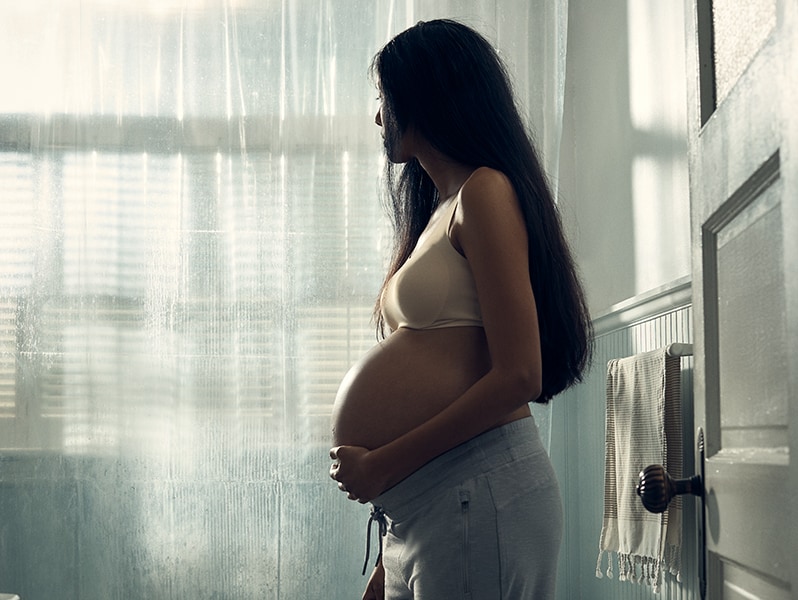Published On January 27, 2020
KIM MANFREDI FANTASIZED ABOUT crashing her car into a massive tree, but was terrified that if she told anyone, her six-month-old son would be taken away. Alicia Nelsen worried obsessively about her newborn but couldn’t understand why she wasn’t deeply in love with him. Anxiety kept her from sleeping more than two hours a night, a panic attack landed her in the emergency room and once, in a rage, she kicked a hole in a wall of her house.
After enduring months of severe postpartum depression, both mothers tried to end their lives with drug overdoses. Manfredi’s husband rushed her to the ER after finding her unconscious; an inpatient stay in a psychiatric ward was followed by months of counseling and a course of drug therapy. Nelsen awakened from her overdose, confessed to her husband that she had tried to kill herself and embarked on a long road of recovery involving medication and psychotherapy. The women finally emerged from their anguish and became the kinds of mothers they desperately wanted to be. Now both of them are advocates for sufferers of postpartum depression and mood disorders, and both run peer support groups.
While many of these women feel blindsided by their mental state, experts find it unsurprising that mental health issues might arise or intensify amid the stress of pregnancy and early motherhood. “If you have a history of depression or anxiety, you’re going to be more vulnerable during pregnancy or postpartum,” says Edwin Raffi, a perinatal and reproductive psychiatrist at Massachusetts General Hospital’s Center for Women’s Mental Health.
The experiences of Manfredi and Nelsen—and of many others whose suicide attempts succeed—represent a little-known subset of a broader problem. American women die in alarming numbers during pregnancy or in the first year after giving birth, and the rate of such deaths in the United States is comparable to those in Afghanistan, Lesotho and Swaziland. These statistics, and the headlines that have accompanied them, have brought unprecedented efforts to prevent or treat the medical problems—hemorrhage, preeclampsia, infection and cardiomyopathy—that often lead to those deaths. A new program created by the American College of Obstetricians and Gynecologists, for example, trains hospital obstetrical teams how to respond to childbirth emergencies.
Yet a significant fraction of those maternal deaths involve new mothers who commit suicide or accidentally overdose on substances. Almost a third of young, healthy mothers who die before their babies’ first birthday fall into one of those two categories, according to a number of state medical committees that have been looking into the problem. “According to some reports, suicide and drug overdose actually cause more deaths than postpartum hemorrhage, cardiovascular events or other pregnancy-related medical problems,” says Kimberly Mangla, a perinatal and reproductive psychiatrist at Columbia University Vagelos College of Physicians and Surgeons.
Mothers at risk of suicide are often not identified in the same way as those who have more straightforward medical problems. “Although major depression is relatively common during pregnancy and postpartum, many women suffer in silence, afraid of the stigma of admitting their sadness and that they can’t bond with their babies,” Raffi says. And even when clinicians do find women suffering from mental illness during the perinatal period—from the beginning of pregnancy through the first year after childbirth—as few as one in 10 gets appropriate care and recovers. Not only is screening for depression and other conditions inadequate, says Lee S. Cohen, a perinatal and reproductive psychiatrist who directs the MGH Center for Women’s Mental Health, but “women are failed on the other side of screening because of all of the obstacles in getting treated.”
Now a few initiatives are beginning to tackle this overlooked, more complex part of maternal mortality. “Women are literally speaking to us from their graves, telling us how they came to die,” says Marcela Smid, a maternal-fetal and addiction specialist at the University of Utah who sits on one of Utah’s investigative committees. “It’s our job to learn as much as we can from them and to try to prevent these kinds of deaths in other women.”

WHEN A MATERNAL DEATH occurs, a maternal mortality review committee, or MMRC, will sometimes step in. Created by state or local governments, these bodies are charged to look into the deaths, report them to the Centers for Disease Control and Prevention and make recommendations about future prevention. Not all states even have the groups, many do little more than look at hospital records and death certificates and few measure the mental health aspects of the problem. Some MMRCs, however, have recently taken on this last task and appointed suicide experts, forensic pathologists and psychiatrists to help determine the causes of all maternal deaths that occur during the perinatal period.
In 2016, Colorado’s MMRC reported that 30% of the maternal deaths in the state over a nine-year period had been caused by accidental overdoses or suicide. In Utah, in a similar span, pregnancy-associated maternal mortality rose 76%, largely because of a spike in drug-related deaths fueled by the opioid epidemic. According to CDC data, the number of women using opioids at the time of delivery more than quadrupled between 1999 and 2014, from 1.5 to 6.5 per 1,000 deliveries.
The work of California’s MMRC has been particularly revealing. A special committee that included a medical examiner, psychiatrists, criminal justice experts, psychologists and obstetricians looked at “any woman’s death where there was an inkling of suicide,” according to Elliott Main. Main is a clinical professor of obstetrics and gynecology at Stanford University and medical director of the California Maternal Quality Care Collaborative, which has been credited with cutting the state’s maternal mortality rate in half. He was particularly interested in piecing together which drug-related deaths might actually have been suicide attempts. “We interviewed family members and studied toxicology reports to rule out accidental overdose,” he says.
The committee found that suicide accounted for 4% of California’s pregnancy-associated deaths from 2002 to 2012. Main says he believes that all of the new mothers who committed suicide had a “good to strong chance” of being alive today if medical professionals had intervened with proper treatment. Most had mental health conditions before becoming pregnant and nearly a third used illicit drugs—missed opportunities to get women into treatment and on to recovery.
SPECIALTY DOCTOR GROUPS AND the U.S. Preventive Services Task Force endorse screening all pregnant and postpartum women for depression. But physicians in one specialty—pediatrics—might be particularly well positioned to spot problems. A depressed new mother will most likely take her infant to the recommended seven well-baby visits, even if she doesn’t have the energy, motivation or insurance coverage to seek care for herself. Earlier this year, the American Academy of Pediatrics called for screening postpartum women for depression and postpartum psychosis, a rare and much more serious problem that often leads to suicide, during four of the well-baby visits. They also noted that fewer than half of pediatricians currently looked for depression in new mothers.
Another entry point is the HealthySteps pediatric program, which promotes healthy development for babies and toddlers and primarily focuses on low-income parents. Its protocols mandate maternal depression screening in the 164 pediatric practices that integrate HealthySteps in their practices. “It’s going to be much more difficult to improve developmental and emotional outcomes for a six-month-old if mom is depressed,” says Rahil Briggs, national director of HealthySteps. When a mother screens positive for depression or substance abuse, a HealthySteps specialist, most often a psychologist or social worker in the pediatric practice, makes a referral to in-house or community mental health services and follows up to ensure she gets treatment.
Yet even when physicians provide all recommended screenings, some women in emotional distress will insist they don’t have a problem. To help those new mothers, Colorado’s Department of Public Health is experimenting with a public awareness campaign about postpartum depression that is designed to bring family and friends into the equation. “We need to involve partners, grandmas and best friends who can spot symptoms of depression,” says Mandy Bakulski, maternal and infant wellness manager at the Colorado Department of Public Health & Environment.
As part of this campaign, young mothers and fathers have written blogs and appeared in videos to explain postpartum depression in English and Spanish, and hotlines have been set up to answer questions. The department has also worked with Medicaid to approve reimbursement for three depression screenings during pregnancy and the first postpartum year. Screenings of new moms during well-baby visits are now also covered.

THESE AND OTHER INITIATIVES help identify women in emotional distress. But the next step—finding appropriate treatment in an overburdened mental health system—can be even more challenging. “We know that a very small proportion of women who screen positive for depression will get an appointment with a mental health provider,” says Nancy Byatt, associate professor of psychiatry and ob/gyn and population and quantitative health sciences at the University of Massachusetts Medical School in Worcester. One study found that only 8.6% of pregnant women and just 6.3% of postpartum women received adequate treatment for their depression.
To combat that part of the problem, Emily Miller, assistant professor of obstetrics and gynecology, psychiatry and behavioral sciences at Northwestern University Feinberg School of Medicine in Chicago, launched a program that embeds psychotherapy and perinatal psychiatry services into Northwestern’s obstetric clinics. That means an obstetrician can now send a woman with mental health disorders down the hall to Collaborative Care Model for Perinatal Depression Support Services (COMPASS). If a patient’s problems aren’t complex, the OB may be encouraged to handle them with support from COMPASS staff, who keep tabs on all referred patients. “Every week, an OB, a psychiatrist, a psychologist and social workers review every woman’s progress and we’ll change the care plan until she gets better,” Miller says. “This frees up our perinatal psychiatrist to see the most complex patients without a long wait.”
Still, there aren’t nearly enough perinatal psychiatrists to go around, so the MGH Center for Women’s Mental Health trains other physicians to deliver specialized treatment to perinatal women. Perinatal psychiatrists at the center evaluate women with complex mental health disorders and develop treatment plans for community psychiatrists to follow—an approach that enables center specialists to consult on the care of 1,200 women each year. Psychiatrists located far from the hospital can take the center’s online course in reproductive psychiatry and consult by phone with perinatal psychiatrists. “By leveraging digital technology, a psychiatrist in Casper, Wyoming, can get the same consultation from a perinatal psychiatrist as a psychiatrist on Beacon Hill in Boston,” Cohen says.
Other approaches help obstetricians and other primary care providers not only to recognize illnesses in perinatal treatment but also to provide mothers with immediate help. For example, the state-funded Massachusetts Child Psychiatry Access Program for Moms offers telephone consultations with five perinatal psychiatrists for advice on treating women with depression and other psychiatric problems. “When providers know they can call an expert for help, they feel much more comfortable managing these illnesses themselves,” says medical director Byatt, who started the program in 2014.
In about one in five cases, the specialists on the phone will conclude that a woman needs to be under the care of a psychiatrist—and will see that patient face-to-face within two weeks, making recommendations to her OB on how to manage her care until she can be treated by a local psychiatric provider. Encouraged by the success of this program, which has provided consultations for 1,471 physicians in Massachusetts, 14 programs in other states have received funding to replicate the model.
Byatt, however, wants treatment for depression by an obstetrician to become as commonplace as managing diabetes. To that end, she and her colleagues at the University of Massachusetts Medical School created a second program—an intensive intervention called the PRogram in Support of Moms (PRISM). The program trains nurses and social workers already working in OB practices to develop a registry of patients with depression and to keep close tabs on their progress for up to 12 months postpartum. That approach is now being tested in a randomized trial funded by the CDC.

OBSTETRICIANS OFTEN ARE WARY about prescribing antidepressants to perinatal women, but they frequently don’t hesitate to give them opioids. In Utah, for example, 42% of women covered by Medicaid and about 20% of privately insured women get opioids for pain during pregnancy. Nationally, three-quarters of women who have a caesarean delivery and one in four who have a vaginal birth are prescribed opioids, according to a recent study in JAMA. This widespread prescribing leads to some 77,000 women a year who continue to fill opioid prescriptions for months after birth—and some may be headed toward opioid addiction, says Smid of the University of Utah.
Of course, many women are already there, and during pregnancy and the first postpartum year they face several distinct dangers. Often they’ll stop using drugs once they learn they are pregnant. “Some of my patients with the most severe opioid use disorder have private insurance, are married and have jobs, and are very good at hiding their drug use,” Smid says. Yet trying to wean themselves from opioids on their own increases the odds of adverse outcomes, and as many as 80% of women who stop taking drugs during pregnancy will relapse within a year postpartum.
Legal issues further complicate matters. Many clinicians don’t screen pregnant women for substance use in part because they fear what may come next. “You want to screen to give women the treatment they need, but you don’t want to leave a woman vulnerable to potential prosecution,” says Northwestern’s Miller. In 23 states and the District of Columbia, a pregnant woman found to be using illegal drugs can be charged with child abuse, and in even more jurisdictions, health care providers must report suspected prenatal drug use to child welfare authorities. In addition, when opioids or other drugs are found in a newborn, mothers may lose custody, at least temporarily. “We are criminalizing a medical problem,” Smid says. “The goal should be for moms to disclose drug use so they can get treated and get healthy. But most women are terrified of talking about drug use or relapses because they are acutely aware of the consequences.”
Pregnant women with opioid use disorder who are receiving medication-assisted therapy (MAT) have improved outcomes for themselves and their babies compared to women who are not on MAT, and are less likely to have accidental or intentional overdoses. But one option for MAT—going to a methadone clinic—often isn’t available in rural areas, and even in cities it may be challenging for mothers, especially with children in tow. The other drug for MAT, buprenorphine, is more convenient, but only providers who complete eight hours of training can prescribe it, and those clinicians can treat only a limited number of patients.
The HOPE Clinic at MGH attempts to overcome some of these barriers by providing a network of coordinated care, with a goal of helping patients navigate pregnancy, early parenting and substance use recovery at the same time. “Many are struggling with social-environmental stressors and barriers to care, such as homelessness, lack of insurance, trauma, violence or a partner who has substance use issues,” says MGH’s Raffi, who also works at the clinic. “And there’s a lot of guilt and shame. We want to help the recovery of mothers with substance use disorders, aid their mental health care and prevent tragedies such as suicide, infanticide or death by overdose.” Women can continue receiving services, including parenting education and recovery coaching, at the clinic for up to two years after giving birth. Other integrated models for addiction treatment have started to pop up in other places, and the CDC recently partnered with 12 states to increase access to treatment for perinatal women with opioid use disorder.
The momentum for mental health services marks a welcome change, says Stanford professor Main, and one long in coming. But innovations in screening for suicide and drug overdose risk shouldn’t stop at perinatal women, he says. “Women shouldn’t die during pregnancy or postpartum, so they serve as the canary in the mineshaft as a warning for problems in our system,” he says. “A perinatal woman’s suicide gets attention. But for every suicide, there are 100 or more people with mental health issues that aren’t being treated. We need to do a much better job helping all of these people.”
Dossier
“Association of Punitive and Reporting State Policies Related to Substance Use in Pregnancy With Rates of Neonatal Abstinence Syndrome,” by Laura J. Faherty et al., JAMA Network Open, November 2019. This analysis found that states that criminalized substance use during pregnancy were associated with greater rates of NAS.
“The California Pregnancy-Associated Mortality Review: Pregnancy-Associated Suicide, 2002–2012,” by California Department of Public Health, Maternal, Child and Adolescent Health Division, 2019. This report looks at 99 pregnancy-associated deaths from suicide.
“Maternal Self-Harm Deaths: An Unrecognized and Preventable Outcome,” by Kimberly Mangla et al., American Journal of Obstetrics & Gynecology, March 2019. The authors outline the barriers and biases that thwart pregnant women from seeking mental health care.
Stay on the frontiers of medicine
Related Stories
- New Tools for Depression
At long last, new therapies—including heat treatments and psychoactive drugs—are offering relief for people with depression.
- Something in Your Voice
New speech analysis technologies can help diagnose mental illness. But they also raise troubling questions.
- Can AI Save Us from Despair?
Psychiatry is finding its footing with machine intelligence. New tools may dramatically help those who need it the most.